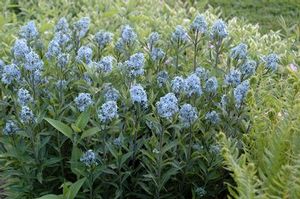New Moon Nurseries

Bluestar is suitable for use in rain gardens, ornamental landscapes, and for attracting pollinators.
Amsonia tabernaemontana
Bluestar, Blue Dogbane
Native to North America
FIRST IMPRESSIONS: Eastern Bluestar boasts a striking growth habit, clean attractive foliage and pale blue starry flowers. Plants develop a handsome shrub-like form with dense growth and yellow fall color. Plants are resilient and adaptable to most garden situations. As a bonus, this Bluestar is tough enough to require almost no maintenance.
HABITAT & HARDINESS: Eastern Bluestar is native over a wide range of the Eastern United States from USDA Zone 4 to 9. Plants occur as far north as New York and south to Florida and the Cajun prairie remnants in southern Louisiana
Habitats are generally moist sunny sites including open woodlands, gravelly seeps, stream banks, limestone glades, moist sandy meadows and wet prairies.
PLANT DESCRIPTION: Eastern Bluestar is a sturdy warm season perennial. Plants have a lovely vase-shaped growth habit that becomes more striking with age. Mature plants average 3’ tall and 3’ wide
Foliage is dark green and narrowly oval or lance shaped. Spring blooms are lavender blue and star shaped. During Autumn, foliage is tinted in a lovely clear yellow shade.
Plants are particularly beautiful during the spring transition. Leaves are lime green as they emerge. As the leaves attain full size, clusters of deep blue pointed flower buds appear and unfurl into star shaped florets.
CULTURAL & MAINTENANCE NEEDS: Eastern Bluestar is very adaptable and easy to grow. It tolerates moist sandy to heavy clay soils and is drought tolerant once established. Plants will also thrive in certain types of wetlands.
Plants flourish in full sun or partial shade but may flop is shade is too dense.
A slightly toxic latex sap causes this plant to be unpalatable to insect pests and foraging herbivores like deer and rabbits. Ruby throated hummingbirds, large carpenter bees, hummingbird moths and butterflies seek the floral nectar.
LANDSCAPE USES: Tidy foliage and a striking vase shaped growth habit allow this Bluestar to perform well as an Accent plant. It can also be used as a Butterfly Nectar Plant, Butterfly Host Plant or as part of a Group or Mass. Plants inject seasonal interest (Fall Color and Showy Blooms) into the garden and are valuable components of Cottage Gardens, Deer Resistant Plantings, Water-wise Landscapes, Low Maintenance Plantings, Meadow or Prairie Gardens, Perennial Borders, Shade Gardens, Wetlands and Wildlife Gardens.
COMPANION & UNDERSTUDY PLANTS: Eastern Bluestar blooms coincide with those of meadow phlox, false indigo and beard tongue. The golden fall foliage is attractive with fall asters like ‘Raydon’s Favorite.
Other Amsonias like the closely related Willow Amsonia can be substituted if this one is not available.
TRIVIA: Selected by the American Horticultural Society as one of the 75 Great Plants for American Gardens.
Grows in most of the eastern states (except New England) and as far west as east Texas.
Amsonia is a member of the Dogbane Family (Apocynaceae). Family members like the infamous oleander typically have milky or viscous sap that can be loaded with highly toxic alkaloids. The Bluestars’ latex sap is mildly irritating and not considered to be harmful to humans. It does make the plant unappealing to foraging deer and many garden pests. Eastern Bluestar is host to the coral hairstreak butterfly caterpillar which apparently has developed a taste and tolerance for the repellant milky sap.
Height:
2-3 ftSpread:
2-3 ftUSDA Hardiness Zone:
4-9Bloom Color:
BlueAmsonia tabernaemontana Characteristics
Attributes
- Drought Tolerant
- Dried Flower
- Cut Flower
- Clay Soil
Exposure
- Full Sun to Partial Shade
Deer Resistant
- Deer Resistant
Flowering Months
- June
- May
Foliage Color
- Green
Soil Moisture Preference
- Moist
Interesting Notes:
For more information on this plant, visit the USDA PLANTS Database: http://plants.usda.gov/java/profile?symbol=AMTA2